






























Official Journal of the Institute of Explosives Engineers


















































This Month’s Features:
The Bombs Below the Woods Insights from a Specialist NATO Meeting The Invaluable Work of Felix Fund



































































































This Month’s Features:
The Bombs Below the Woods Insights from a Specialist NATO Meeting The Invaluable Work of Felix Fund


























If you were responsible for the Defence budget for the next ten years…




































































































































Meet the Team Monday: Gareth Collett
European Federation of Explosives Engineers
The Bombs Below the Woods Fellows of The IExpE
Insights from a Specialist NATO Meeting
The Invaluable Work of Felix Fund
If you were responsible for the Defence budget for the next ten years…
DISCLAIMER: The opinions expressed in Explosives Engineering are those of the authors concerned. They do not necessarily represent the views of the Institute.
Front Cover: Image from The Invaluable Work of Felix Fund by Andy Oppenheimer. Read more on page 20.
Given our continued growth, IExpE are now registered for VAT. There will be no increase in Membership Subscriptions as these are exempt, however other services provided by IExpE will now be subject to VAT.
























New Registrants
Daniel Lewis - CEng
Zarack Scott - CEng
Danielle Thacker - EngTech
New Members
Fellow
Patrick Bowles
Sharon Broome
Andrew Hambley
Member
Charlotte Baggot
James Colman
Kevin Doyle
Emily Eaglesham
Gavin Edmondston
Richard Ellis
Daniel Flynn
Adam Galloway
Mike Garcia
Poppy Hilliard
David Jagger
Christopher King
Andrew Lane
Rafael Lim
Joseph Lyons
Alexander Makowski
Darren Marshall
Anna Martinez
Luke Mittins
Jennifer Louise Mungham
David Munro
Paul Nolan
Yong Jian Ong
Gregory Powell
Xu Qiaoyu
Jenny Roberts
Joesph Sadler
Cong Yao See
Michael Spencer
Iain Sutton
Danielle Thacker
Jack Thorpe
Michael Williams
Wei Yong Wong
Technical
Andrew Claydon
Yongsheng Huang
Shun Jie Leong
Jessica Merritt
Victor Lee Roberts
Chun Kheun Siew
Dun Hui Yet
Associate
Megan Armson
Pamok Taamsri
Student
Matthew Benjamin
Samuel Gowland
Steven McAllen
Samuel Philips
Mia Pierce
Joseph Rula
Joseph Smith
Company
Thaline Resources Ltd







Our people are our power. Valuing and investing in individuals is the key to our success and the cornerstone of our culture. We are proud to foster a workplace where health, wellness and inclusivity thrive.
Joining Roxel UK is more than a job – it’s a chance to contribute to sovereign capability; securing the vital interests of our customers whilst achieving your full potential. Roxel UK is an exciting, rewarding, and respected place to work and grow.
Over 20% of our team are in our Early Careers Programmes (Apprentices and Graduates). We work together to meet our customers’ most challenging demands.









By Emily Hunt

Gareth Collett heads up strategic development of the OME ‘Explosives Engineering’ offer at UWTSD. With an extraordinary track record of over 34 years strategic leadership in the British Army, Gareth’s experience in explosives engineering spans the world’s most complex and sensitive challenges.
Aside operational service in Northern Ireland, the Balkans, Iraq, Afghanistan and North Africa, examples include explosion risk reduction for the Royal household, mitigating explosion risk on a stranded oil tanker surrounded by sea mines in Yemen, investigating the Beirut Port disaster, contributing to war crime investigations such as the Mariupol Theatre tragedy, and running multi-billion pound platform counter measure protection programmes for Defence.
A Chartered Explosives Engineer, accident investigator, and risk manager, Gareth’s world-class expertise is underpinned from roles as a Defence Board Advisor, head of the UK’s bomb disposal profession and Chief Technical Advisor to the United Nations. He now leads in higher education as an Executive Director, shaping the next generation of defence and security professionals.
In his personal time, Gareth is deeply committed to giving back. He is a Trustee for the Felix Fund Bomb Disposal Charity, a Freeman of the City of London, an Ambassador for REVIVE and Action on Armed Violence, and advocate for causes close to his hearturological cancer research and PTSD awareness.

Fun fact: At his CBE investiture in 2013, Gareth and Her Majesty discussed the suitability of Corgis in bomb disposal. Whilst the outcome remains a personal secret, there was an agreement that long grass may prove difficult.
UWTSD are truly proud to have Gareth leading the OME team – Thank you Gareth!

By Ruth Barber, UK representative: ruthbarber@iexpe.org
The Council Meeting of EFEE took place in Porto with an excellent attendance. The following country representatives were present: Austria, Belgium, Bulgaria, Germany, France, Ireland, Poland, Slovakia, UK, Estonia, Czech Republic, Italy, Sweden, Portugal, Finland, Denmark, Switzerland and Turkey.
There were three representatives of individual members and two representatives of corporate members and eleven non-voting delegates and guests including the Secretary General of FEEM, Mr. Vincente Huelamo. We were delighted to welcome Azhar Mahmood Malik the General Manager of JAMHex and his brother who travelled from Pakistan to address the meeting about their work in the manufacture of commercial explosives. They both expressed their enthusiasm for working with EFEE in the future. Mark Hatt stated that he will be resigning from Council after the Spring 2025 AGM. John Wolstenholme has been elected Chairman of the Constitution Committee following a vote of the members.
Top of the agenda was the upcoming 13th EFEE World Conference which will take place in Krakow, Poland from 20th to the 23rd September 2025. Details of the conference are available at www.efeeworldconference.com
The 14th EFEE world conference will take place in Copenhagen in 2027. Preparations for this event are currently underway.
Membership
EFEE is keen to ensure that the organisation is worthwhile and attractive for members. The website is a valuable resource and working well and EFEE is currently organising a webinar which should be available in February 2025.
The focus of the work of the EU Directive Committee was Directive 2011/65/EU better known under the name: Restriction of Hazardous Substances in Electrical and Electronic Equipment (RoHS). The RoHS Directive currently restricts the use of ten substances including lead.
This directive covers also electric and electronic detonators. Some lead components are part of these devices. In the explosive industry there is an ongoing process to find solutions to substitute the existing lead components. This process takes time. There is an existing exemption for using lead components in electric and electronic detonators. This exemption will end on the 20th of April 2026. In principle it is possible to apply for an extension of this exemption. This request must be submitted to the commission latest by the 20th of October 2024. EFEE is starting a survey to find out whether manufacturers consider an extension of the exemption necessary.
From the perspective of most manufacturers more time is required to completely replace the leadcontaining substances. Austin Detonators will submit an application for an extension of the exemption (using lead-containing substances). To support this application we have asked other manufacturers to send us arguments for extending the exemption. The response was very good. We have sent the arguments to FEEM and the arguments will be included in the application for an extension of the exemption. It is expected that the Commission will ask associations and institutions further questions after examining the application.
EFEE and FEEM propose to present a paper at the next meeting of the Group of Experts on Explosives on 19th of March 2025 to explain the reasons for the extension of the exemption.
Nathan Rouse is the new Shotfiring Committee Chairman. John Wolstenholme was elected as a Vice Chairman responsible for running demolition subcommittee. Teele Tuuna gave an excellent update regarding PECCS materials which are nearly updated.
John Wolstenholme will take care of Demolition Guidance. This material will be fleshed out with details to reflect Relevant Good Practice (RGP). It was agreed that John Wolstenholme will attend the EDA conference to participate in the interview with the EDA president.
The next meeting of Council will take place on the 23rd and 24th May in Tallinn, Estonia.
By Matthew Eatough, Lead Risk Assessor


Walking through the woods of this East Anglian nature reserve, you would be forgiven for not realising you were standing on the ground of an old bombing range. The rows of trees and overgrown vegetation do well to conceal a history that has long since faded from living memory.
When Zetica was commissioned to undertake a detailed UXO risk assessment for a proposed habitat restoration scheme at the woods, the first step was to gain an understanding of the military history in the area that might pose a risk to the upcoming works.
As is good practice for any risk assessment, we began by hunting down historical records from both local and national archives. Multiple sources of information were consulted across a range of repositories. The only document seemingly directly referencing the site concerned the use of a maypole shortly after World War One (WWI).
We decided to view the document, hoping it would provide further understanding of the site’s history. Remarkably, we found that a portion of the papers detailed concerns over the planned use of the maypole… due to the presence of unexploded bombs (UXB) in the ground.
Further digging indicated that part of the area had once been used as an aerial bombing range.
We set about gaining some more detail, and after much investigation, uncovered an operational war diary for the No. 4 School of Navigation and Bomb Dropping, Royal Flying Corps (RFC). This confirmed the existence of a vast bombing range on the southern part of the site. Established in 1917, it was used by RFC training crews to fly practice bombing runs and drop munitions on mock targets.
We then tracked down a series of aerial photographs dating from 1918, which revealed unprecedented detail of the range.
The photographs showed hundreds of individual targets carved into the ground. These included a mock airfield, with dummy aircraft, technical buildings and hangars, and a railway station, with accompanying platforms and marshalling yards.

Also apparent from the photos was the significant levels of cratering visible across the range, indicating its heavy use. Typically, both live and practice bombs were dropped on such WWI ranges. These bombs had identical casings, making distinguishing between live and practice UXBs problematic.
At the end of the war the bombing range was abandoned, and during the 1920s the land was acquired by the Forestry Commission.
A pine forest was subsequently planted across the site, masking all evidence of any military activity. By the start of World War Two (WWII) the area was unrecognisable, comprising rows of woodland, intersected by forestry trails.
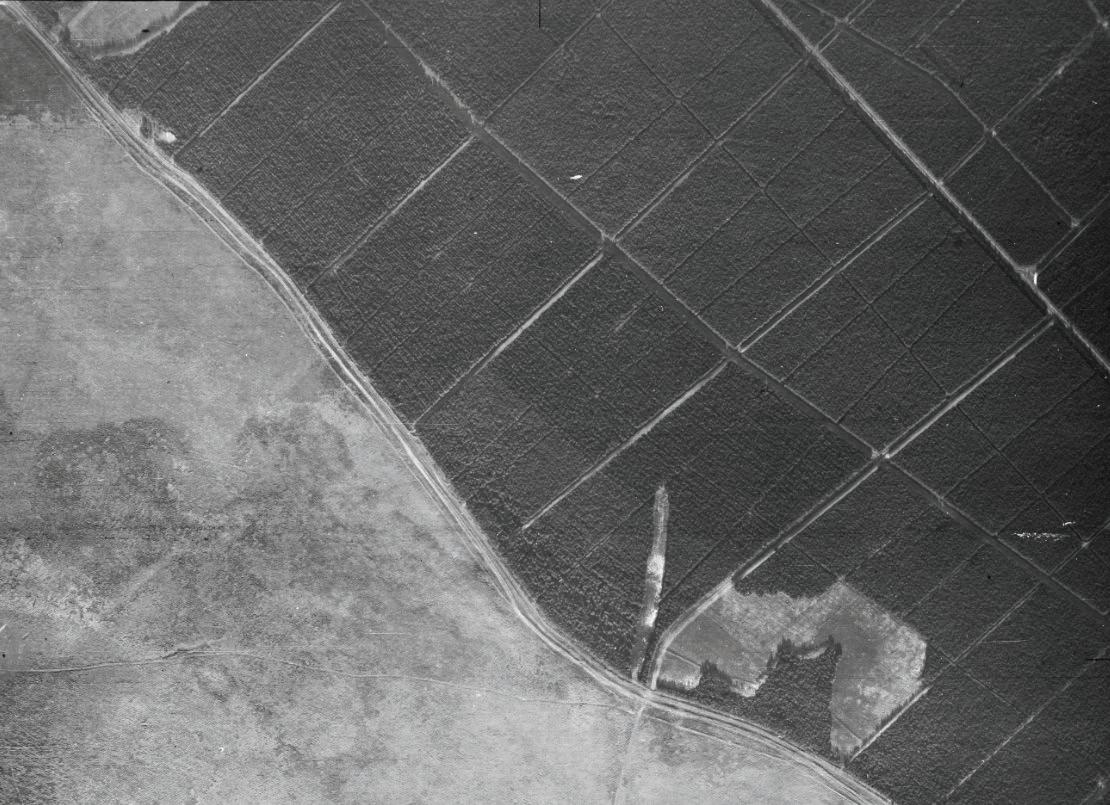
And so the WWI range was forgotten.
We then found additional records from World War Two (WWII) indicating a second bombing range was established on heathland to the southwest of the site. Although this was located some distance away, it was considered close enough to pose a potential hazard due to the inherent inaccuracies with practice bombing operations. Some evidence was also found to suggest that training took place at the range involving infantry, tank, and artillery units.
Due to the discovery of the WWI bombing range, and subsequent WWII range, we concluded that there was an elevated risk of encountering UXB on the site, with the main target areas posing the most significant hazard. The potential for encountering other UXO, such as Land Service Ammunition (LSA), due to infantry training could also not be discounted.
Our findings were collated into a comprehensive UXO risk assessment, which advised on appropriate mitigation measures. The client was planning to undertake archaeological excavations, followed by soil mulching to a depth of 0.8m. A non-intrusive geophysical survey was recommended to map potential shallow-buried UXO.
To support the initial archaeological excavations, we devised a modified geophysical platform to allow a non-intrusive magnetometer survey to be towed between the trees. We were able to identify and locate potential UXO targets which the archaeologists could avoid.
For the next phase, the client needed to cut down a section of woodland. UXO awareness briefings were provided to the forestry teams in case they encountered a suspect item.
Advice was also given on appropriate forestry machinery (i.e. tracked vehicles with low ground pressure) to reduce the chance of accidentally detonating a bomb.
Once the woodland had been felled, we undertook a towed geophysical survey across the site. In under three weeks we surveyed over 70 hectares of land. A magnetic technique was used to detect the anticipated ferrous UXO.

As suspected, the results revealed dense concentrations of magnetic anomalies in the former target area.
A trial investigation was made on a handful of anomalies to confirm the findings of the UXO risk assessment, and we uncovered a UXB.


A full target investigation was now required. Due to the likelihood of encountering further UXO, we mobilised a dedicated Explosive Ordnance Disposal (EOD) team through our SiteSafe Alliance Partner Ramora UK, for the duration of the target investigation. >>
>> This team established a disposal facility at a remote location on the site so that any UXO upon discovery could be quickly dealt with.
In the following investigation, 88 items of UXO were uncovered, as well as more than 250 pieces of ordnance scrap. The most common finds were 16lb and 20lb Hales bombs, as well as 20lb Cooper bombs, all commonly used on WWI bombing ranges.
Some items of WWII ordnance were also recovered, including 25lb artillery shells and 2” mortars.















Frazer-Nash is a world-class engineering consultancy, specialising in the field of ordnance, munitions and explosives (OME), and their integration into complex weapons systems and platforms. We provide independent and professional expertise, advice, guidance and direction to deliver tailored scientific and technical solutions; from design to disposal.

With proven experience in the development of timely, high quality independent OME safety advice and system safety, and suitability for service (S3) support, our highly-skilled and experienced engineers understand the complexity of any and all challenges your organisation faces.



Whether your need is large or small, you can count on Frazer-Nash to support your goals. Many of the world’s leading private and public sector organisations trust us to overcome their most complex challenges.



Find out how we can add value to your organisation: email defenceweapons@fnc.co.uk or visit our website www.fnc.co.uk.









“Working with complex weapons, munitions and ordnance runs in my family line with my Dad and late Grandfather – between us, we have over 100 years munitions experience.”
I started working with munitions and explosives for the UK MoD in 1992 as a Strategic Weapons Apprentice at the Royal Naval Armaments Depot (RNAD) Coulport and I was captivated from day one.
Seeing a Polaris missile disembarked from an SSBN then being shown and taught how it was disassembled, critically inspected, processed, tested and put all put back together again whilst safely was rather cool for a young man! I grew up to respect these people, their knowledge and the safe systems of work in place for all staff working within an explosives establishment/high hazard environment… and it’s something I carry forward to this day and that I am passionate about, explosive safety and the safety of people working with explosives.
On completion of my apprenticeship in 1996, I moved internally from RNAD Coulport to RNAD Beith where I started out as a young technician responsible for explosive processing, testing, and supporting in-water trials of the new at the time BAE Systems Spearfish Heavyweight torpedo. During my 18 years at RNAD Beith I went on to hold a variety of positions. From managing missile production during Afghanistan/Iraq wars, the introduction of new complex weapons into MoD service, quality management, explosive stock management and to explosive licencing/disposals.

Leaving the MoD in 2014 I joined Thales Optronics and Missile Electronics (OME) based in Glasgow. At Thales I was responsible for leading the manufacturing and explosive processing departments to deliver on a variety of safety and arming units (SAU) orders/programmes. The SAUs are installed on various complex weapons to initiate the warhead system.
I was appointed SME in Glasgow, leading explosive safety, explosive processing/disposal, and explosive licensing.

In 2018, I applied and was accepted as a Member of the Institute of Explosive Engineers (MIExpE) with an institute sub-discipline of WOME (Weapons, Ordnance, Munitions & Explosives).
In 2020, I moved to BAE Systems based at Bishopton. A rather unique site in its purpose, which is to environmental test and qualify weapons, ordnance, munitions and explosives to current UK MoD Defence Standards.
This gives BAE Systems the in-house opportunity to carry out environmental testing and qualification of its own munitions thus keeping projects within the BAE’s control.
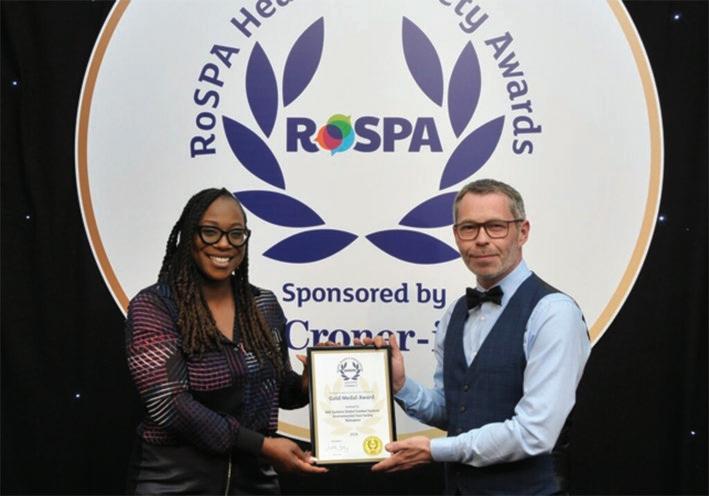
BAE Systems Bishopton winning ROSPA Gold Award 2024
Having served as Principal Engineer Test & Evaluation (T&E) and then Technical Manager T&E at Bishopton for over four years, I moved to High Hazard Advisor T&E North within Central SHE in 2024, supporting the Munitions business with the knowledge and experience that I have gained in the explosives/ munitions industry over the last 32 years.
And what does this mean for you?
Working with complex weapons, munitions and ordnance runs in my family line with my Dad and late Grandfather, I followed in their footsteps beginning in RNAD Coulport – between us, we have over 100 years munitions experience, so this Fellow recognition is my acknowledgement to both of them for all of their stories, mentoring, guidance and support they gave to me over all these years. Many thanks Ron Smith and George Smith.
Attaining Fellow status gives me a sense of pride and personal achievement for the work that I have carried out over the last 32 years in this industry.
And a lot of it……I can’t talk about.
What does the role of a Fellowship in BAE Systems look like to you?
As a Fellow of the Institute, I provide WOME advice/guidance within BAE Systems and support the wider explosives community where I can. My current role as High Hazard Advisor with the company fits that bill rather nicely, where I can use all of the knowledge and skills I have gained to help BAE and it’s people. I feel I am giving something back, which I find very rewarding.
Explosives safety first, no compromise.
What do you see the industry looking like in 10 years?
The manufacture of explosive material/munitions will change as nano-thermite technology and the use resonant acoustic mixing of explosives for military use evolves.
Weaponry and warfare will look very different in the next 10 years as Hypersonic weapons, UAVs and UUV’s become more mainstream in defence, where more lightweight munitions or lethal packages are required by design but still deliver a punch.

Richard Douglas Watson MSc FIExpE (nick name Soapy).
What is your career history?
An accomplished and highly experienced Senior Leader and Manager, Richard has held key positions in all aspects of EOD/UXO, including operations, training, and health and safety in both military and commercial sectors. With strong senior management and leadership skills, he leads by example.
He appreciates operational strategy and fiscal commercial requirements, and can deliver highlevel management within these specialist activities to organisations.
Richard has over 40 years of experience in UXO and EOD, across both commercial and military sectors. In his former career in the Royal Navy (RN), he was a Commissioned Officer and a deep specialist in Diving and Mine Warfare Officer in EOD/UXO operations, both maritime and on land.
Since leaving the RN, Richard has developed extensive knowledge of commercial practices, where his strong leadership and guidance have helped provide world-class training in specialist activities such as Diving and Submarine Rescue and Escape.
From 2021 to 2023, Richard was the Deputy EOD Superintendent for James Fisher Subtech, where he was responsible for all operational, logistical, and academic requirements for EOD projects. He operated under the new guidelines of Low Order techniques during EOD campaign for the SOFIA Wind Farm in late 2022. >>

>> He has also served as a Senior UXO/ EOD Client Representative and QA/QC Consultant for projects in the Southern North Sea, East Coast of the UK, Irish Sea, and German, Danish, and Dutch sectors, providing specialist UXO consultative
advice and overseeing, guiding, and directing contractors on behalf of clients during UXO survey and investigation operations. He holds the position of Senior UXO Client Representative, mentoring and guiding other Client Reps, both onshore and offshore. Richard also worked with N-Sea as the EOD Diving Superintendent and PM in 2024.
Richard is now the Operations Manager at Northern Divers Engineering-Hull, where he manages the business and is currently building a UXO Identification Diving capability for near-shore OWG projects. Richard is an active individual who stays fit by walking his two Cockerpoos and participating in high-impact gym classes.
He is also an endurance marathon kayak athlete, having completed the Devizes to Westminster International Canoe Race (125 miles in 24 hours). Richard has been married to Suzanne for 36 years, and they have two sons, both currently serving in the Armed Forces: Alex in the Army (L-Cpl, 35 EOD, Wimbish) and Ben in the Royal Navy (Leading Airman and Rugby Player for RN and Combined Services).
What first attracted you to the industry?
From the age of 19, while in the RN on a Diving Team, EOD was my “bread and butter”. The thrill of arriving at a job, identifying explosive hazards, and taking action was fascinating, and I remain deeply enthusiastic about the industry to this day.
What does it mean to you to become an IExpE Fellow?
Becoming a Fellow is recognition of my specialist knowledge at every level, both military and civilian. It acknowledges my ability to safely operate in the EOD field, dealing with the same threats and safety procedures, though in different arenas-military and commercial.
To date, what has been the highlight of your career?
Probably Gulf War 1, where I conducted EOD operations in a live theatre of operations, diving on live buoyant mines, ground mines, and land EOD.

What do you see the industry looking like in 10 years?
In 10 years, the Explosive Ordnance Disposal (EOD) and Unexploded Ordnance (UXO) Identification and Clearance industry will likely undergo significant changes driven by advancements in technology, automation, and artificial intelligence. These developments will reshape operations, improve safety, and potentially reduce the costs associated with UXO clearance.
Here’s an exploration of how these trends might manifest:
• Lift and Shift UXO as a primary course of action
• AI and machine learning integration
• Remote operations and telepresence
• Safer, Faster, and more cost-effective operations
• Regulation and international collaboration
• Environmental and ethical considerations
Conclusion
The UXO clearance and EOD industry in 10 years will likely be characterised by a shift toward automation, remote operations, and AI-driven decision-making.
“Lift and Shift” will become a more prominent strategy, facilitated by advanced robotic systems and drones. The combination of AI, machine learning, and advanced sensor technologies will make UXO clearance faster, safer, and more cost-effective, while reducing the need for human presence in dangerous zones. Ultimately, these innovations will result in a more efficient, safer, and environmentally responsible UXO management and clearance process globally.



The NATO specialist meeting, AVT-394, held in Koblenz, Germany in October 2024, gathered experts from NATO countries, including Canada, Germany, the UK, Finland, Denmark, Switzerland and the USA, to evaluate advancements in water sampling, monitoring, and remediation techniques aimed at mitigating munitions-related contamination in live-firing ranges.
As a current PhD student at the UK Defence Academy, funded by Cranfield University and the Ministry of Defence under the CBRN Educational Programme and supervised by Professor Tracey Temple and Professor Frederic Coulon, I had the opportunity to attend and present at the specialist meeting. My research focuses on representative sampling methods for hazardous chemicals released by industry, warfare or terrorist acts. My background in forensic science and analysis has enabled me to build a broad scientific basis, thus aiding me in understanding diverse scientific approaches.
Presenting a paper on my current research explaining the importance of a well thought through sampling plan for post-blast water sampling, was a great and invaluable experience. This opportunity allowed me to network with experienced industry peers and engage in valuable knowledge exchange.
The meeting was part of the 54th AVT Panel Business Meeting (PBM) and aimed to promote military live-fire range sustainability. Contamination from munitions constituents such as heavy metals, explosives residues, and propellants, which have migrated to surface and groundwater in their respective training areas, has been documented by several NATO nations.
Understanding contaminant migration is crucial to minimising adverse effects and preventing potential range closures. The goal of the meeting was to bring experts in water sampling and monitoring together with specialists experienced in remediation and control techniques. The meeting provided a platform for transferring knowledge gained throughout the NATO community to the broader defence community. Spanning three days and seven sessions, the meeting kicked off with a keynote address, followed by presentations on water monitoring strategies.
Keynote Address: A German Perspective
LTG Hanjo Neue, the first keynote speaker, provided a German military perspective on environmental issues associated with live firing and training ranges. He discussed Germany’s regulatory framework, which prohibits environmental pollution but allows exemptions for military operations where compliance is impractical. An emphasis was placed on the separation of regulatory authority and operational responsibility, aiming to streamline environmental management for training ranges.
He also introduced Germany’s efforts to map and classify training ranges under the European NATURA 2000 biodiversity framework, which had previously excluded military areas. To bring his talk to a close he outlined a staged vulnerability analysis process to address contamination, including risk assessments, hydrogeological studies, and remediation measures such as water control systems and wastewater treatment. The keynote highlighted the importance of departmental cooperation to facilitate the management and mitigation of environmental pollution. This is the case in many industries including CBRN related incidents, where cooperation stands at the forefront.
Water Monitoring Strategies
Monday started off with session one under the umbrella of water monitoring strategies. The evolution of monitoring programs, the implementation of environmental solutions, and the development of new tools were discussed.
Presentations featured the Canadian Armed Forces’ environmental risk management program, which uses a passive approach in combination with monitoring of receptors for early warning signs.
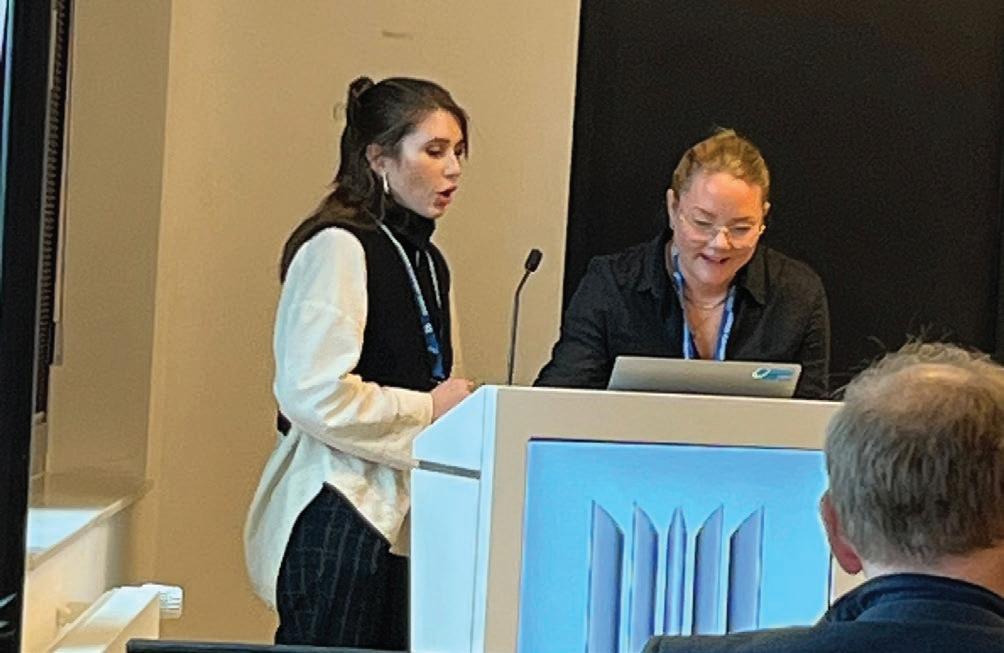
Long-term impacts on water quality, particularly regarding heavy metals, were discussed. A spatial data model for mapping flow routes in Range and Training Areas was introduced to improve water protection planning. Underscoring the need for robust sampling techniques and quality control, Johnson’s work showed large fluctuations over time in sampling of surface waters as well as a need to reanalysis of samples due to laboratory error. The presentations from this session were from Canadian, Finish and Norwegian Defence. Surprising to me was the passive approach by the Canadian Armed Forces to monitor the environmental risk through use of an automated risk evaluation tool.
Session 2 delved into interpreting water sampling data for environmental assessments. The second keynote address was given by Sonia Thiboutot, who presented the history of US-Canada collaboration on environmental sustainability, especially in hydrology, with efforts dating back to the 1980s addressing contamination risks. Larson from the Danish Defence Estates Agency shared data from a century-old Range and Training Area, showing minimal impact on local waterways outside the training area. This is due to the munitions being contained in marshland and sandy soils. Lapointe et al. highlighted challenges in arctic conditions, where slower degradation of munition components and thus increased toxicity necessitate caution in expanding training activities in these environmental conditions.
An interesting point to take away is that it took over 10 years to convince military owners of the risk of contamination from munition constituents even though scientific evidence was present. Therefore, scientific research has value past the inception of the ideas and knowledge generated but can affect significant change later on.
Session 3 focused on underwater munitions sites, which have historically been used to dump unwanted munitions. These sites are now under growing scrutiny for potential health and environmental risks. The inception of the ‘Maritime Underwater Munitions’ module for the Explosives Ordnance Engineering MSc run at Shrivenham, shows the importance of spreading awareness and teaching about these issues to the new generation of Explosive Engineers.
While most underwater sampling has shown low contamination levels, questions remain about the adequacy of current sampling methods.
A Swiss representative of Amasuisse real Estate Kaiser discussed concerns about munition contamination in Swiss lakes, while American research under Lotufo highlighted high contaminant concentrations near the source, emphasising the need for further investigation. The dumping of ammunition has been a significant issue and is investigated in the UK, Germany and Switzerland to name a few. Three papers explored sampling methods and mitigation techniques, with Lotufo documenting PICIS (polar organic chemical integrative samplers) as a reliable and sensitive method in time varying conditions. Passive samplers have been utilised in studies relating to wastewater as well and have wider applications in other research areas.
My own research demonstrated representative sampling poses a challenge as explosive residues in water present a heterogeneous contamination pattern. Traditional grab sampling (GS), while simple and cost-effective, often produces highly variable results due to its limited spatial and temporal scope. Composite sampling (CS) aims to address these limitations by pooling multiple samples, but it may dilute trace contamination, leading to reduced detection sensitivity. The 3D-Multi-IncrementSampling (MIS) method, although more complex, systematically captures contamination across spatial dimensions, enhancing representativeness.
This was shown in an in-situ experiment where six pipe bombs—three using high-order detonations and three using low-order deflagrations—in 1000 litre water-filled intermediate bulk containers (IBCs) were detonated. Post-detonation samples were collected using GS, CS, and 3D-MIS methods to evaluate their efficacy. High-order detonations yielded low residual TNT, while low-order deflagrations left significantly higher concentrations. Quality control measures, including field blanks and duplicate samples, were implemented to ensure accuracy.
It was found that GS provided the fastest results but exhibited high variability. It was most effective for preliminary hazard mapping but limited in reliability for low-concentration residues. CS on the other hand reduced analytical costs and time but underperformed at detecting low-level contamination. >>
3.

>> Finally, 3D-MIS yielded the highest recovery rates and effectively captured heterogeneous contamination patterns. However, it was the most resource-intensive method, requiring extensive planning and equipment.
This study highlights the importance of selecting appropriate sampling methodologies based on specific objectives and constraints. The remaining talks focused on remediation efforts utilising activated carbon (AC) and biochar. Both British research from Cranfield University under Perisco et al. and Finish research under Kopponen tested activated carbon (AC) and biochar for removing TNT from water, finding both materials effective, with ground rice husk emerging as a sustainable alternative to AC. While Persico et al. achieved significant remediation of contaminated water in the laboratory, Kopponen managed to treat TNT and RDX contaminated ground water from a Finish training range with 95% reductions of contamination at a total cost of 1€/L. The real-world applications for these remediation measures are significant aiding the cleanup of leeched munition constituents in groundwater and water bodies but may also have wider applications for other hazardous compounds.
Session 5 addressed the issues with the treatment of contaminated water on the range as infrastructure such as electric power is not accessible, hence all remediation must be driven by gravity. Finish Defence Research presented by Pihkala discussed methods to mitigate runoff from shotgun ranges, such as bioremediation with willow and using the marsh surface as a biofilter.
Lead pellets scattered on the surface and corroding are an issue as lead is easily mobilised, so valuable data can be gathered from this study for wider application on civilian ranges for example. University of Finland’s Väisänen et al. introduced a novel 3D printed polypropylene 4D Scavenger filter filled with ion exchange resins for metal removal. 90% of lead and 60% of copper were successfully removed from contaminated water. National Defence Canada’s Cloutier presented back-stop systems for mitigating heavy metals and energetics at small arms ranges. However, a drawback here is the required maintenance of these backstops. The session stressed the importance of integrated, cost-effective systems for managing contaminants across different ranges in the field.
Day three set off with the last session led by Canadian research focusing on the environmental impact of ammunition containing perchlorate and the risks associated with its disposal. Open detonation of rocket motors has left significant unburned perchlorate, which is highly soluble in water and poses threats to drinking water as well as ecosystems. Studies demonstrated that improper disposal methods led to groundwater contamination. Key lessons emphasised the importance of proper combustion and understanding local geology and hydrology to manage risks. Munitions containing perchlorate are
increasingly destroyed as their shelf life is coming to an end, thus increasing the risk of contamination as evidenced. Therefore, other disposal methods or the mitigation of perchlorate leeching into the environment are fundamental concerns in current research.
Finally, the meeting ended with a panel discussion on the effects of climate change on military ranges. In Norway, increased precipitation is expected to cause more flooding and erosion, while milder winters will lead to greater damage during exercises. Similar trends were noted in Switzerland and the Netherlands, with rising sea levels and increased flooding risks for the latter.
In Canada, warmer temperatures and droughts will increase the risk of thawing and thus munition release, while in the USA, climate uncertainty presents challenges related to leaching contaminants, more extreme weather events, and flooding of military facilities. These emerging issues show the importance of exchanging mitigation measures across countries to be prepared for future challenges.
The NATO specialist meeting highlighted the importance of innovative water sampling and remediation techniques in ensuring the sustainability of military training ranges while minimising environmental impact. By adopting these measures, the long-term viability of live-firing ranges and protection of surrounding ecosystems can be achieved. Collaboration and knowledge-sharing among nations remains crucial for advancing the science and technology of sustainable range operations, and future efforts should focus on integrating new technologies while proactively managing risk. The NATO research community gathers for these specialist meetings frequently, facilitating the exchange of specialist research and allowing for further generation of knowledge relating to many areas of concern, not only limited to environmental challenges with live firing ranges.
The meeting emphasised the importance of robust sampling methodologies and quality control in environmental monitoring, directly applicable principles to the focus of my PhD. Presentations on the mitigation of munition constituents, such as heavy metals and explosives, closely mirrored the challenges I face in quantifying hazardous chemical agents in diverse environmental settings. Thus, the methodologies discussed aligned with the challenges of my own research and provide transferable insights into developing sampling plans tailored for highrisk scenarios, such as chemical attacks and industrial chemical spills.
Image captions:
1. Koblenz

2. Sally Webb briefing the NATO delegates
3. The Rhein-Mosel Halle where the NATO conference took place
4. NATO insignia
























































By Andy Oppenheimer
On New Year’s Day 2025, a pick-up truck was driven at 70 mph into a crowd on Bourbon Street in New Orleans, killing 14 and injuring 35. A potential IED was also found in the truck and other viable IEDs that had been planted in street coolers nearby were rendered safe by Explosives Ordnance Disposal (EOD) teams following the attack. Bomb making precursor materials were also found at a rented home which the suspect had tried to burn down.
Days later on 8th January in central London, several “controlled explosions” were carried out after Regent Street was evacuated. In November, a suspect device was reported at Euston Station. Although there were no IEDs involved, EOD teams had to swiftly deal with each situation. Over several decades spanning the bombing campaigns of the Provisional IRA in Northern Ireland and mainland Britain, and since then by many other terrorist groups, EOD teams have saved hundreds of lives while potentially risking their own on every bomb disposal mission, especially in the early days before Remotely Operated Vehicles (ROVs) and other EOD equipment came into use. In the present day in the UK alone, EOD - bomb techs - attend around 3,000 call-outs every year. This article focuses on the work of the renowned Charity which gives invaluable assistance to serving and veteran EOD operatives.
Felix Fund’s early role
The Felix Fund Bomb Disposal Charity was founded in 2011 and is based at Vauxhall Barracks in Didcot. Its prime aim is to reduce the mental stress endured by EOD and Search Teams in the course of their duties. Many people outside of the services are unaware of the constant stress that bomb disposal and Search personnel face almost daily, from highly pressured situations. This continued exposure to intense stress as well as physical injury, can have lasting mental and physical effects.


As a small specialist charity, Felix Fund has achieved significant impact with cutting-edge services provided for hundreds of EOD operatives. The Charity first provided normalisation breaks for hundreds of bomb techs and search teams on their return from Afghanistan and Northern Ireland. The breaks were designed to identify or reduce the impact of mental stress that these high-pressure tours produced. The sessions consisted of therapeutic team-building activities lasting for a week, with discussion groups to draw people out and share their operational experiences. The breaks provided the opportunity for EOD colleagues with shared operational experiences to regroup and reinforce peer bonds. They proved vital in identifying and reducing the risk of poor individual mental health.

The Dashboard programmes
From 2015, Felix Fund has focused on mental health help - with specially designed programmes based on the concept of mindfulness for preventative stress training. The Charity’s Dashboard courses were set up to provide a greater understanding of what creates stress, and to help develop ways and skills to deal with it.
These programmes provide serving military with the techniques to recognise warning signs of stress. Participants are helped to develop their ability to relax, clear their minds, and focus on positive aspects of their lives, enabling them to become more ‘present’, while helping them deal with negative self-talk, anxieties and struggles. This positive mindfulness training then feeds back into a more productive and positive work and home environment.
To date, more than 1,000 EOD and Search personnel have taken part in the Dashboard courses, with excellent results. Feedback to the Charity confirms how life changing and even life-saving the courses have been for many serving personnel and veterans, and their families.
There has been a 98% positive response to the course and what it delivers, with 90% stating they would encourage colleagues to attend. Some 80% also stated they would continue with the meditation and breathing techniques.
There are also two Spouses/Partners Dashboard weekends run each year. These weekend courses allow ten partners to experience their own training. As the partners of serving personnel, they have their own stresses and issues, most notably not knowing if a loved one is going to return home as well as how different the person who returns may be. Felix Fund offers them the same support that their partners receive.
The Charity also provides a mini on-site version of Dashboard for serving personnel at their workplaces. This is a two-day course which Felix Fund takes to the regiments or units enabling those who may not be able to attend a week-long version of the course due to work or personal commitments. It is now also acting as a form of triage for those who require the expanded version. The on-site course includes discussions on stress, sleep, and how to recognise and combat issues, as well as a relaxation session at the end of each day via a guided meditation. The courses are designed for up to 20 personnel, serving across all aspects of EOD & Search. These stand-alone, on-site, two-day workshops can act as a refresher for those who have already attended the residential course, as well as providing a taster for those who were unable to attend the full programme.
Since its founding in 2011, Felix Fund had by the end 2024 distributed over £2m in grants and assistance to individuals in the EOD and Search Team communities, and the Charity has raised over £3.5 million. This is an outstanding testament to the huge amount of donations the charity has received from the EOD and Search community. As well as being keen to help their own, external supporters and corporations have shown their respect for the vital job these professionals carry out.
The Charity continues to provide financial assistance to hundreds of serving military, veterans and their dependent family members when facing hardship. Some noted recent examples include:

• A hand bike for a veteran injured in Iraq
• Equipment for a former Clearance Diver to care for his tracheostomy
• Help to furnish a new home for a wife and child fleeing domestic abuse
• Support for the nursey at Carver Barracks, Wimbish
Requests for grant applications can cover anything from mobility equipment to home adaptations, funeral costs, and specialist support. The Charity has also launched a publishing arm, Felix Fund Publishing. Its first publication, The Long Walk: An Anthology by EOD & Search Veterans, published in 2023 with a second version in December 2024, is a compilation of memoirs and stories from EOD techs. It has also begun delivering a regular podcast on the website.

Fetch Felix!
Felix the Cat is the unofficial mascot of British Military Explosive Ordnance Disposal and Search teams – as cats have nine lives and the ability to land on their feet. Based on the cartoon cat Felix originally created by Otto Messmer, the Felix Fund mascot was drawn by an AT (Ammunition Technician), SSgt Brian Shepherd, who served in Northern Ireland in the 1970s.
The adoption of ‘Felix’ arose after a young signaller went to the Officer Commanding 321 Squadron to ask which radio call-sign to use. The OC, having lost two operators that morning, decided on ‘Phoenix’ - to reflect the Squadron rising again from the ashes to conquer terrorism in Ireland. The signaller misheard this as ‘Felix’ and it never changed. Since then, whenever Bomb Disposal personnel find a suspect device, they still use the phrase ‘Fetch Felix’.
Sponsorship and support
Several notable companies specialising in EOD equipment, training and services have become sponsors of Felix Fund. The Charity operates mainly through donations and various fund-raising activities, including raffle prizes, auction lots, or other gifts in kind. People can be sponsored at sporting events and marathons, challenge activities, and Felix Fund can be chosen as your Charity of the Year.
For more information about supporting Felix Fund or how the Charity may be able to help you, please visit: www.felixfund.org.uk or email: enquiries@felixfund.org.uk. You can also follow Felix Fund on Facebook, X, Instagram and LinkedIn.
Andy Oppenheimer AIExpE MIABTI is an independent CBRNE analyst, former editor of CBNW Journal and Jane’s NBC Defence, and author of IRA: The Bombs and the Bullets (2008). He became Editor of the Felix Fund Newsletter in January 2025.
All photos ©Felix Fund. Photo captions:
1. An EOD operator takes the long walk
2. EOD teams have risked their lives on every bomb disposal mission, especially before ROVs such as the one being deployed in this photo came into use
3. Yoga on a Dashboard course
4. ECM veteran Mick Brennan is pictured with his new hand bike
5. The Felix Fund logo
If you were responsible for the Defence budget for the
1. Introduction
The defence landscape is a constantly evolving collection of capabilities and countermeasures, such as new higher performance explosive compounds, better detection hardware and advanced software driven by the likes of Artificial Intelligence (AI) [1]. During the Explosives Ordnance Engineering (EOE) MSc, Cranfield University enables students to investigate increasingly imaginative ways that explosives can be used and countered. It is an interesting proposition to ask us, what we would do if we were handed a lump of the approximately £50 billion that the UK and MOD spends on defence every year[2]
Realistically, I would have to share out this £50 billion fairly between personnel, maintenance, services, and lots more. Therefore, in this article, I plan to focus on purely where some investment in the explosives ordnance space could yield some excellent results over the next 10 years. Through this short article, you should get a clear picture of the current threats and technologies, their potential countermeasures, and how these emerging technologies could further evolve over the next 10 years. Information has been taken from academic papers, government documents, and news outlets to give a scientific viewpoint adjusted for government and social issues that also present as factors in the explosive ordnance space.
The current defence landscape is fascinating. Anyone can currently watch on the likes of Instagram and X, in real time, the development of ever more complex munitions, delivery systems and defence mechanisms[3]. The war in Ukraine enables a unique opportunity to analyse the weapons and tactics that are deployed by relatively more advanced countries, which allows the defence sector to identify and fill current and future capability gaps.
Threats from adversaries have evolved significantly since the British Army was last fully involved in an active warzone. The British Army have moved away from rifling, in favour of smooth bore. Due to this, the long-range High Explosive Squash Head (HESH) rounds are no longer viable, as a result of their reliance on spin stabilisation that is not met with the new smooth bore barrels. Smooth bore does potentially mean that some newer propellants
and explosives such as 4,4’-Dinitro-3,3’-diazenofuroxan (DDF) and Hexanitrohexaazaisowurtzitane (CL-20), could be used to improve projectile range and target effect performance. Smooth bore will also allow for easy use of missiles in tank divisions, which would fulfil the range requirements, replacing the spin stabilised HESH rounds.
Delivery systems are a very relevant topic currently due to the war in Ukraine. For example, both Ukraine and Russia’s use of drones to deliver explosive charges in a variety of different situations are proving very effective[4] Remote controlled drones are also proving very hard to defeat. Signal jammers can be used to disrupt and control the drone; however, pilots have started connecting kilometres of fibre optic cable to overcome any jamming effect to still deliver the payload. Drones are proving a highly versatile and cost-effective solution to take out anything from personnel to armoured vehicles[5]
Technology has come a long way in protecting personnel and systems since the early days of early explosive threats. New armour systems for personnel and vehicles, utilising ceramics, specialist fabrics, and armour shape have all contributed to better protecting personnel[6]. It is now imperative look forward and consider emerging threats and critically analyse our UK response to stay ahead of the curve and be prepared for the next 10 years of explosive ordnance threats.
Unlike some of the wealthier counterparts overseas, the UK defence sector must spread its resources a little thinner[2]. To assess whether investment is viable, there will need to be a realistic threat that our current explosive ordnance will not be effective, or that our current prevention/ protection systems will not be sufficient against potential threat. Much of horizon scanning in explosives ordnance is speculation[7]. Most countries keep their specific capabilities highly classified.
For primary investment, it is worth considering the current capability gaps that armies face. Some of those current capabilities are drone warfare, new energetic compounds e.g. CL-20, 2,4-Dinitroanisole (DNAN), Insensitive High Explosives (IHE) and materials advances, that help make armour lighter, safer and more capable at absorbing or deflecting explosive effects.
The capability advances in explosives are extensive. The UK and allied forces must all conform to various safety regulations, and although explosives such as CL-20 produce some very impressive effects, their sensitivity is simply too high currently to be a viable option for use in current systems[8]. We must consider that some countries, due to being at war or just having a more relaxed view on safety, will be more willing to risk lives to gain superiority in explosive capability[9][10]
When it comes to selection of explosive ordnance technology for investment, I will be considering the current and future need for the selected capabilities, budget limitations that certain technologies may present, and how strategically important introducing and maintaining some capabilities may be. Climate effects will also be considered where relevant.
4. Proposed Technologies for Investment 4.1 New Explosives
2,4,6-trinitrotoluene (TNT), hexahydro-1,3,5-trinitro1,3,5-triazine (RDX) and octahydro-1,3,5,7-tetranitro1,3,5,7-tetrazocine (HMX) have been industry standard high explosives for most of traditional warfare. Research into any new explosives has been heavily impeded by sensitivity limitations, environmental problems and safety concerns.

New compounds, such as CL-20, are very popular areas of research currently due to their excellent explosive performance. The problem faced by researchers is the very sensitive nature of CL-20. A recent paper by Bolton and Matzger investigates the use of TNT as a stabiliser. When used in a 1-1 mix, this appears to be successful[8]. The problem that storage and transport organisers face is, when adding heat, the two components separate, and the pure CL-20 absorbs into the TNT. This is not ideal if you need safe handling or operation[11]. CL-20 is also expensive to produce[11]
Other new and high-performance explosives that are currently being researched and implemented include dihydroxylammonium 5,5′-bistetrazole-1,1′diolate (TKX-50) and DNAN. TKX-50 is a promising replacement for current secondary explosives. TKX50 has the advantage of being relatively inexpensive to synthesise, has low toxicity and low sensitivity[12] Altogether, TKX-50 has the possibility to be more powerful, safer and more friendly to the environment than most other secondary explosive options. Research into TKX-50 is interesting as it faces problems with photodegradation when compared to
other nitro explosives[13]. TKX-50 could be extremely useful in dealing with safety and environmental concerns around explosives if the photodegradation issues are solved. As such, TKX-50 is a worthy inclusion for explosives ordnance investment.

Recently, TNT is being replaced by DNAN, as seen in explosives like BAE’s IHE formulations. DNAN shares many qualities with TNT, low sensitivity, the ability to melt-cast and has similar explosive performance[13] DNAN has a lower sensitivity than TNT and therefore is safer to manufacture, transport, store and use. Due to this, DNAN is beginning to replace TNT in many cases[13]
DNAN does face some problems as the University of York discovered when looking into the environmental effects of explosives. They discovered the negative effects on plant life was worse than TNT. TNT contaminated zones have previously been combated using genetically engineered plants to detoxify the land. DNAN poses threat to this solution, “Plants appear to lack a natural mechanism to combat the toxic effects of DNAN, causing it to persist within the plant and exhibit toxicity even at significantly lower concentrations.”[15] DNAN is a clear example of the potential threat posed by novel explosives on the environment. It is evident that significant funding is needed to either modify the compounds to make them less toxic to the planet or invest in natural environmental solutions to deal with contaminated land after the explosive has been used.
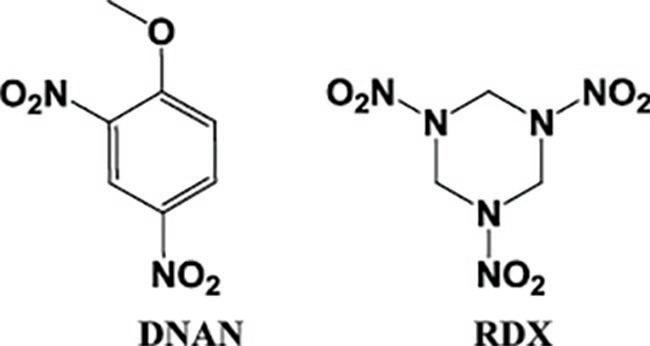
It will be interesting to monitor the development of novel high explosives and the solutions to their potentially damaging environmental effects. In view of defence spending, I feel novel high explosives are something that despite high cost, environmental problems and sensitivity/safety problems, are worth investment. Novel high explosives present opportunity for safer production, handling, and use. Adding to this, more powerful explosives are worth considering as armour and blast protection systems advance with the use of ceramics and fibres. >>
If you were responsible for the Defence budget for the next
If you were responsible for the Defence budget for the
Drones and unmanned systems are widely discussed in mainstream media due to their use and excellent performance in Ukraine. Drones currently remove hundreds of thousands of pounds worth of equipment from functional use with a drone and payload that in total would cost under $500[16][5].

Drones have a clear place in modern warfare. However, weapons designers are quickly developing anti-drone munitions, e.g. the Nordic Ammunition Organisation (NAMMO) with their 40mm programable air burst round that is very effective at dealing with the threat drones pose[17]. Now that designers are bringing in counter measures for Unmanned Aerial Vehicles (UAVs), investment is needed to improve resistance to threats or improve ability to allude the tracking and measuring systems used to programme the ammunition. China have reportedly just commissioned the world’s first dedicated naval drone carrier[18], giving a significant indicator the direction that modern warfare is heading. The UK must begin investing into UAV’s and other unmanned system countermeasures. Some current countermeasures include radio frequency (RF) jammers, GPS shooters, high power microwave (HPM) devices, programable airburst rounds, nets, high energy lasers and cyber take over systems[19]. Many of these systems are very effective but have various negatives ranging from high cost to affecting the other important battlefield capabilities when in use.
The current methods of detection and disposal lean heavily on Ground Penetrating Radar (GPR) and robot assistance. The current GPR systems for most countries are secret and as such, it is hard to speculate about the current in-service capability. However, many other fields investigating with GPR - e.g. the geological, mining and archaeology communities - encourage research to continue outside the umbrella of defence. GPR began development for explosives and defence in the 1970s but really took off after the Gulf War, and the huge demining operations that had to take place after[20]. GPR works well for vehicle and man mounted land mine detection and is certainly an area for more investment. There are multiple studies trying to increase depth of GPR, which is currently effective to about 50cm depending on soil density, temperature, terrain etc. Many studies also have begun to look at GPR being used form the air. Drone mounted GPR already exists for many other industries where a shallower penetration is required[21], and I see no reason that it shouldn’t come across to the explosives search

and disposal space. Drone mounted GPR to search for explosives would remove the need for heavy vehicle mounted systems and a human casualty-free search. Some new research by OSMO labs proposes the potential for scent detection/ encoding with the use of chemical sensors and Artificial Intelligence (AI)[22]. So far, the group have been successful however, the technology is still very young and not verified or useful yet. Technology like this could be a valuable aid for explosive detection systems or for disposal teams working with Improvised Explosive Devices (IED)s for identifying explosive type. The research in this field could be worth investment in the future and I would keep a close watch on the progress over the next 5 years to decide if it has any use for explosive ordnance applications.
4.4.
There are many factors that may affect the ability to invest in explosives ordnance research and capability. Other than the financial, environmental and safety related discussions that are currently popular, it is worth considering other factors that may change how investment into explosives may need to be modified. Technological integration of new systems is generally a defining factor. It is ever more important that as budgets are stretched, new munitions will need to consider old designs, how a new munition may be implemented without a drastic change of platform or, any need for extensive new training. Realistically, most of the investment would be well spent creating a modular system of explosive ordnance. A modular system would comfortably future-proof and enable both forwards and backwards compatibility with a variety of systems and platforms.
5. Conclusion
In conclusion, the explosives ordnance research space is currently very exciting. If I were to oversee the defence budget, the areas fit for investment range from disposal and detection to the actual explosive and its delivery method. For disposal and detection, I would invest into GPR and how it can be best delivered to remove as many people as possible from any danger zone. For delivery systems, I would invest in protecting UAVs from the various methods of attack, while also funnelling investment to the UKs own anti-UAV munitions and systems. It is important to possess explosives to protect and deter however, it is imperative that explosive ordnance has minimal detriment to the environment it is used in. As such, I would invest most heavily into new explosives and how the environmental effects of current and future munitions can be minimised or even completely mitigated.
Image captions:
1. Hexanitrohexaazaisowurtzitane (CL-20)[23]
2. dihydroxylammonium 5,5′-bistetrazole-1,1′-diolate (TKX-50)[14]
3. DNAN and RDX [24]
4. Commercial drone in military environment[25]
5. Drone mounted Ground Penetrating Radar (GPR)[26]
References:
1. Science and technology directorate. Feature Article: The Next Generation of Explosives Trace Detection is Here. 2022. Available: www.dhs.gov/scienceand-technology/news/2022/10/06/feature-articlenext-generation-explosives-trace-detection-here Accessed (ACS): 11/12/24
2. Si Ethell C. UK Defence in Numbers 2023
3. Emerson Johnston. From Tweets to Tactics: The Transformative Impact of Social Media on Modern Warfare Dynamics. Stanford University. 2023. Available: https://fsi.stanford.edu/sipr/tweets-tactics ACS: 11/12/24
4. Mykola Bielieskov. Outgunned Ukraine bets on drones as Russian invasion enters third year. Atlantic Council. 2024. Available: www.atlanticcouncil.org/ blogs/ukrainealert/outgunned-ukraine-bets-ondrones-as-russian-invasion-enters-third-year ACS: 11/12/24
5. Global X. Drones in Defence: Reshaping Modern Warfare and its Economics. Money Management. 2024. Available: www.moneymanagement.com. au/knowledge-centre/drones-defence-reshapingmodern-warfare-and-its-economics ACS: 11/12/24
6. Konstantin von Niessen RG. Ceramic Coatings on Fiber Woven Fabrics for Lightweight Ballistic Protection. The American Ceramic Society. 01/03/06; Available: https://ceramics.onlinelibrary.wiley.com/ doi/epdf/10.1002/9781118370872.ch12?saml_ referrer#accessDenialLayout ACS: 11/12/24
7. Sandford R. Horizon scanning: helping policy makers in an uncertain world. Civil service quarterly. 2016. Available: https://quarterly.blog.gov.uk/2016/01/25/ horizon-scanning-helping-policy-makers-in-anuncertain-world/ ACS: 11/12/24
8. Bolton O., Matzger AJ. Improved stability and smart-material functionality realized in an energetic cocrystal. Angewandte Chemie - International Edition. 12/09/11; 50(38): 8960–8963. Available: DOI:10.1002/anie.201104164
9. UN Safer Guard. International Ammunition Technical Guidelines. UN Safer Guard. 2024. Available: https:// unsaferguard.org/un-saferguard/guide-lines ACS: 11/12/24
10. Chemhat. Regulations in Other Countries. Chemhat. 2019. Available: https://chemhat.org/en/worldwideregulation ACS: 11/12/24
11. Lowe D. Things I Won’t Work With: Hexanitrohexaazaisowurtzitane. Science Adviser. 2011. Available: www.science.org/content/blog-post/ things-i-won-t-work-hexanitrohexaazaisowurtzitane ACS: 02/12/24
12. Chen JB., Yan T., Wang C., Gao R., Xu S., Fan G., et al. The photostability and degradation pathways of TKX-50 as a representative of nitrogen-rich energetic salts in aqueous solution. Journal of Photochemistry and Photobiology A: Chemistry. Elsevier B.V.; 15/04/21; 411. Available: DOI:10.1016/j. jphotochem.2021.113178
13. Hussein AK., Elbeih A., Abdelhafiz M., Ahmed
HS., Shalaby ASA., Azazy A., et al. Sensitivity and Performance of Dinitroanisole (DNAN) in comparison with TNT. Journal of Physics: Conference Series. Institute of Physics; 2022. Available: DOI:10.1088/1742-6596/2305/1/012018
14. Thomas M. Klapötke. TKX-50: A Highly Promising Secondary Explosive. Materials Research and applications. 17/12/20; Available: https://link.springer. com/chapter/10.1007/978-981-15-9223-2_1 ACS: 13/12/24
15. University of York. New Explosive Chemical More Harmful to Plants: Study. 2024. Available: www.york.ac.uk/news-and-events/ news/2024/research/dnan-explosive-harmfulto-plants/?utm_source=miragenews&utm_ medium=miragenews&utm_campaign=news ACS: 02/12/24
16. Tomas Milasauskas LJ. FPV drones in Ukraine are changing modern warfare. Atlantic council. 2024. Available: www.atlanticcouncil.org/blogs/ ukrainealert/fpv-drones-in-ukraine-are-changingmodern-warfare/#:~:text=The%20main%20 feature%20that%20has,than%20five%20hundred%20 US%20dollars ACS: 03/12/24
17. Unmanned airspace. NAMMO Programmable munitions. 2024. Available: www.unmannedairspace. info/c-uas-search/nammo ACS: 02/12/24
18. Sutton H. China Builds World’s First Dedicated Drone Carrier. 2024. Available: www.navalnews.com/navalnews/2024/05/china-builds-worlds-first-dedicateddrone-carrier/ ACS: 02/12/24
19. robin radar systems. 10 Types of Counter-drone Technology To Detect And Stop Drones Today. 2024. Available: www.robinradar.com/resources/10counter-drone-technologies-to-detect-and-stopdrones-today ACS: 02/12/24
20. Daniels DJ. A review of GPR for landmine detection. Sensing and Imaging. 2006. pp. 90–123. Available: DOI:10.1007/s11220-006-0024-5. ACS: 29/11/24
21. SPH Engineering. Ground Penetrating Radar. SPH Engineering. 2024. Available: www.sphengineering. com/integrated-systems/technologies/gpr Accessed: 02/12/24
22. Alex Wiltschko. Scent Teleportation Update: We Did It! OSMO Labs. 2024. Available: www.osmo.ai/blog/ update-scent-teleportation-we-did-it ACS: 03/12/24
23. N/A. Hexanitrohexaazaisowurtzitane. Wikipedia. Available: https://en.wikipedia.org/wiki/ Hexanitrohexaazaisowurtzitane ACS: 13/12/24
24. N/A. Synergistic Effects of IMX-104 Components in Membrane Absorption: A Computational Study. Research Gate. 2024. Available: www.researchgate. net/figure/Molecular-structures-of-DNAN-and-RDX_ fig1_365112540 ACS: 13/12/24
25. SYSTEL. The Future of Warfare: How Drones Are Shaping Combat. SYSTEL. 2024. Available: https:// systelusa.com/blog/the-future-of-warfare-howdrones-are-shaping-combat ACS: 13/12/24
26. SPH Engineering. Study on evaluating airborne GPR’s potential for UXO and Landmine Detection in a Controlled Environment. SPH Engineering. 2023. Available: Study on evaluating airborne GPR’s potential for UXO and Landmine Detection in a Controlled Environment. ACS: 13/12/24
If you were responsible for the Defence budget for the next ten years...
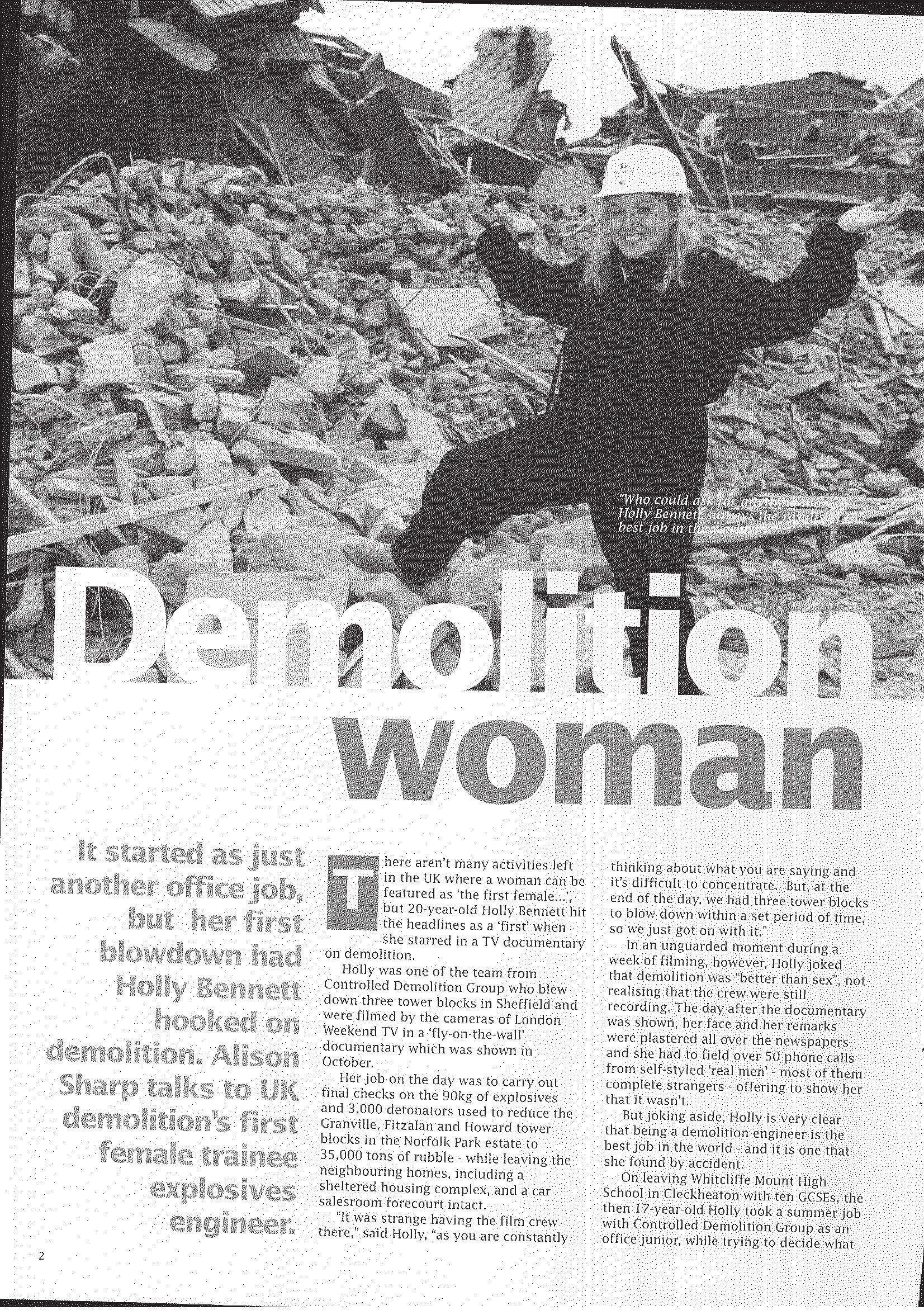

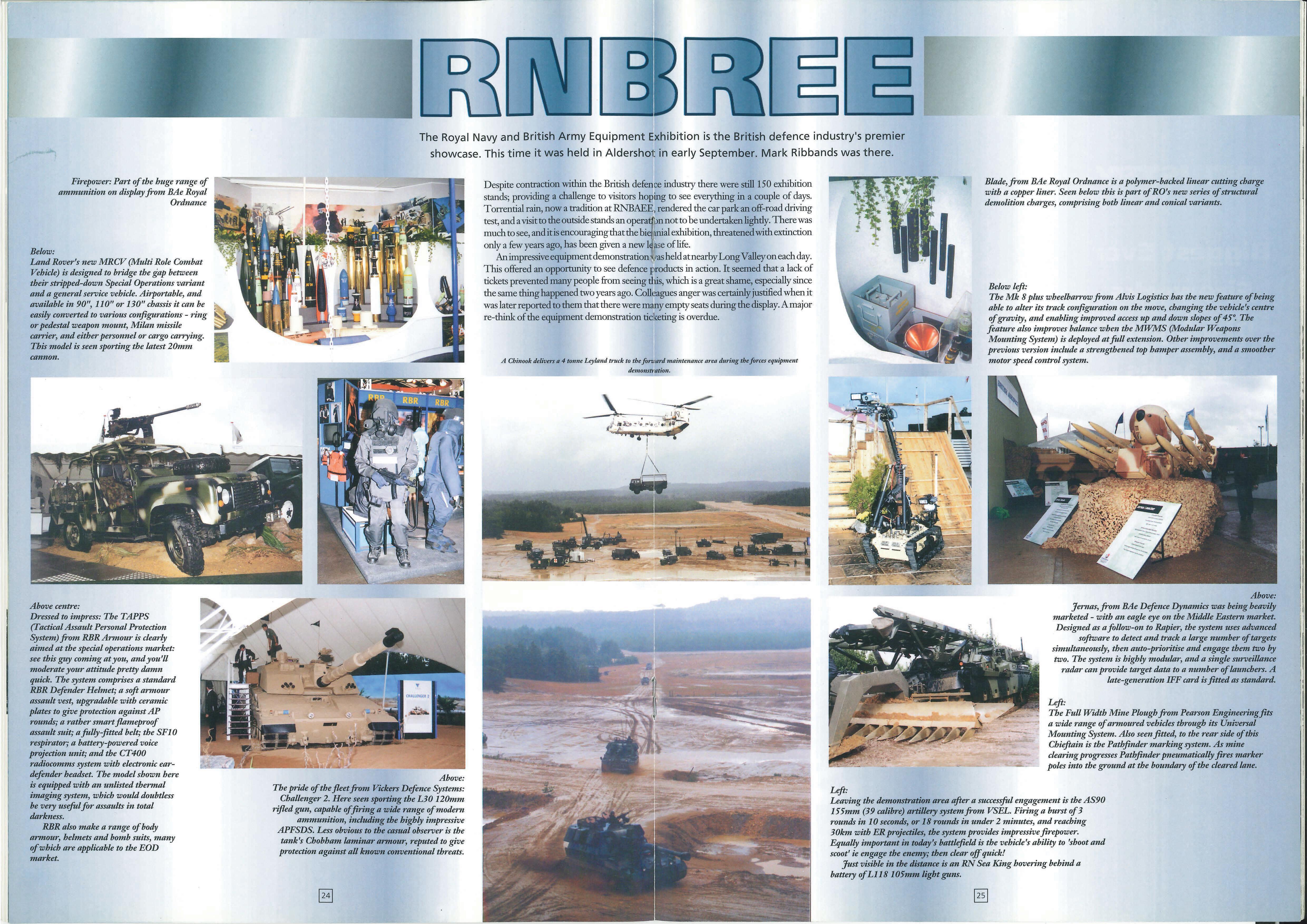





On receiving the 2024 Lifetime Achievement Award!
Your dedication and contributions have made a lasting impact, and this honour is truly well deserved.

Get ready for a fun and creative challenge!
Grab your colours and bring the picture to life - invite your friends, family, and other members to join in the fun! Once you’ve completed your masterpiece, scan and send it to isseykelly@iexpe.org or mail it to: Institute of Explosives Engineers Ground Floor, Unit 1, Greyfriars Business Park, Frank Foley Way, Stafford, ST16 2ST.
Win an Exclusive Institute Prize!
The most impressive entry will be featured in the next issue of the journal, so don’t miss your chance to showcase your talent!
Get creative, have fun, and let’s see what you can do!

Brad Carter welcomed all in attendance to Frazer-Nash Consultancy Networking event. The day began with an introduction by Samuel Yeap, who introduced himself and the Energetics and Vulnerability team.
Samuel delivered a comprehensive presentation on blast modelling, emphasising its critical role in the Weapons of Mass Effect (WOME) industry. He highlighted the importance of numerical modelling as a tool for saving lives, reducing costs, and improving efficiency when compared to traditional physical testing methods.
The presentation featured several examples of his work in blast and impact modelling, showcasing applications such as artillery shell fragmentation, terminal ballistics, and pressure vessel rupture. One example focused on modelling the interaction between shaped charges and explosive reactive armour.
He described how he uses a more advanced software (impetus) and modelling method (SPH) to reassess the SC vs ERA results. He also highlighted the application of this software in modelling more complex scenarios, such as tandem shaped charges.
The session concluded with an open discussion, where members had the opportunity to share their perspectives on blast modelling and its potential evolution within the future of explosives industry.
The second half of the day discussed the importance of bring people into the OME industry. Firstly, Hannah Wiltshire discussed emerging professional pathways and the Graduate schemes they run at Frazer Nash. She talked about STEM outreach hubs which students could access whilst being a graduate.
This was followed by a presentation from Tom Challinor, an apprentice at Frazer-Nash, who shared his personal journey into the OME field. Tom detailed how he initially had no background in OME but discovered his passion for the industry in his final year of studying mechanical engineering.
Thank you to Frazer-Nash Consultancy for hosting such informative and engaging event.
We’re thrilled to officially launch our new and improved Education & Training Accreditation Program - now as our very own Accreditation Centre!
This exciting milestone reinforces our unwavering commitment to supporting Accredited Centres in achieving the highest standards of excellence. With a more robust framework, we’re enhancing the accreditation experience to drive growth, professional development, and educational innovation in the explosives industry.
This industry-specific scheme uses a Training Quality Specification (TQS) that has been designed by explosives specialists, with rigorous standards of competence, compliance and quality management as the focus.

Benefits of Becoming an Accredited Centre
• International Recognition: Be part of a globally trusted network in the explosives industry
• Competitive Edge: Deliver high-quality, industry-approved training that meets client expectations
• Sales and Marketing Support: Leverage the IExpE brand to enhance your market presence and attract more learners
• Quality Assurance: Demonstrate compliance with the highest industry laws and best practices
If you would like further information about the program, please contact: stephanieball@iexpe.org
The IExpE Team attended the Tomorrows Engineers Live Event on Monday 24th February in Westminster London at the home of The Institution of Civil Engineers. It was estimated that 160 + people attended the event from all across the UK.
Attendees were welcomed by Dr Hilary Leevers, Chief Executive, Engineering UK and Dr Janet Young CBE, Director General and Secretary, Institution of Civil Engineers. The events focus was working towards common goals to increase the diversity and number of young people entering engineering careers, which is a key focus of IExpE for 2025.
It was an event full of speakers discussing their research and evidence for delegates to consider in the design and delivery of their engineering and technology outreach strategies and programs. Some key facts that stood out to the IExpE Team were:
• There has been a shift in attitudes towards AI since 2022, where AI is the new data and is mor popular than Taylor Swift. 70% of employees say AI and new technology are impacting the workplace, with 41% increased efficiency, 38% agree that AI and new technology will help them progress faster in their chosen career.
• Hands on practical science has halved in recent years. Girls confidence within the classroom will impact their chosen career choice.
• Girls on free school meals are 15% less likely to feel confident to discuss their careers and are less confident within the interview process of getting a job.
• Becky Parker asked how to get students to do engineering. Her response was ‘Let them do it’. Give them the opportunities within classrooms and get the older students to teach the younger students. Within the ‘Project Earth’, an 8-yearold boy designed and built a robot to collect litter from the beach, with the goal of creating a cleaner environment for his 4-year-old brother to grow up in. She also explained how 4 girls created a device that flashes to inform them of the air quality to help individuals who have asthma. This shows if we give children the opportunities they will take it!
• One key message was to support teachers to enable them to create and give autonomy to teachers.
During the afternoon of the event, there were interactive workshops. These workshops focused on ‘Youth proof to future-proof STEM outreach: why co-design is our missing link’, ‘Engaging underrepresented voices: ethical debates and gamification’ and ‘Strong together: unlock collaborative success’.

There was an unconference hour, which involved discussions led by Code Signatories and Supporters, where delegates had the opportunity to discuss the below topics:
1. How can employers collaborate to attract more young people into STEM? This involved talking about the barriers, pledges and solutions to this.
2. How can we make sure workplace encounters are part of a young person’s school experience?
3. How can colleges support industry with school outreach?
4. Apprenticeships for all: how can we guide underrepresented groups to success?
5. What opportunities exist for cross-sector collaboration (e.g., between schools, government, charities, and employers) to create sustained interest in STEM in underrepresented groups?
6. How can we help young people get the workplace skills that matter?
7. How can we come together as The Code Community to tackle areas of need and ensure we move from good intentions to proper collaboration driving systemic change? For example, improving representation of girls, investing more in evaluation, increasing practical work.
Do any of our members have any thoughts/ideas on the above topics? If so please contact the team on info@iexpe.org. The event was closed by Dr Hilary Leevers discussing unconference session feedback and closing remarks, followed by a drinks reception to conclude an informative and successful event.
































































































Are you ready to showcase your brilliance?













Submit your A1 poster and have the opportunity to present your design during the Networking Night.














Don’t miss the chance to have your work featured at FULMINATION 2025 - a 3 day conference for industry professionals!






























































































































































